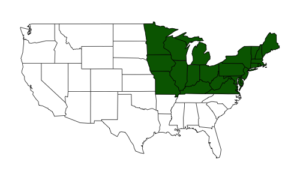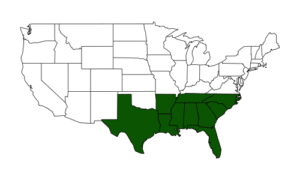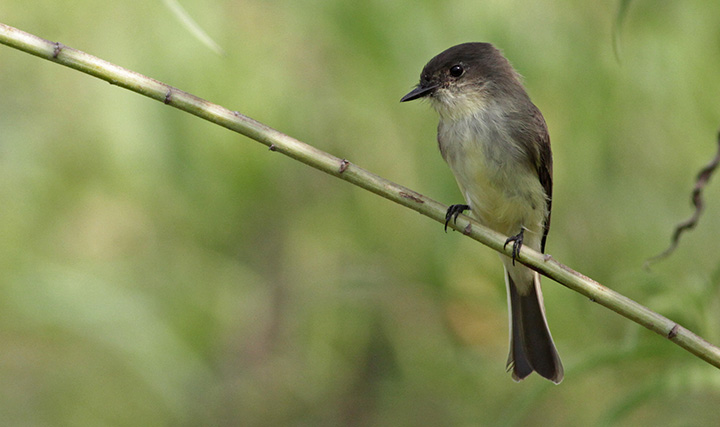Continental Summary
Light to moderate migration, primarily in California and the Desert Southwest early in the period, brought increasing numbers of Bell’s Vireo, Lucy’s Warbler, Yellow Warbler, and Bullock’s Oriole to the West, while slightly more extensive light to moderate movements on Sunday and Monday nights, including Blue-winged Teal, Eastern Phoebe, Blue-headed Vireo, Tree Swallow, and Pine Warbler among other migrants, highlighted the period in the East.
Curious what birds will move next? Check out our regional migration forecast.
Need a review of our definitions for regions, species on the move, and migration amounts? Please visit this link.
Quick Links to Regions
Upper Midwest and Northeast |
Gulf Coast and Southeast |
Great Plains |
West |
Upper Midwest and Northeast
After a damp start to the period, portions of the region, notably from the central Mississippi Valley east to the Appalachians, saw light to moderate movements on Sunday night. These movements expanded in slightly more favorable conditions on Monday night, extending across the Appalachians to DelMarVa. But Tuesday night saw the return of unfavorable conditions to the region that persisted through the end of the period, with marginal winds and precipitation shutting down migration in many areas or limiting movements to minimal to light levels (for example in Virginia on Wednesday night or portions of Pennsylvania and New Jersey on Thursday night).
Top Movers
Increasing
| Species | Increase from Last Week | % of Checklists Reporting |
|---|---|---|
| Tree Swallow | 114% | 5.2 |
| Eastern Phoebe | 253% | 3.5 |
| Green-winged Teal | 67% | 8.0 |
| Red-winged Blackbird | 34% | 40.4 |
| Wood Duck | 48% | 10.0 |
| Common Grackle | 37% | 28.4 |
| Rusty Blackbird | 86% | 3.3 |
| Turkey Vulture | 43% | 20.7 |
| Sandhill Crane | 34% | 6.4 |
| Blue-winged Teal | 101% | 2.0 |
| American Robin | 30% | 42.8 |
| American Woodcock | 70% | 3.4 |
| Pied-billed Grebe | 88% | 3.4 |
| Osprey | 79% | 2.2 |
| Ring-necked Duck | 31% | 15.5 |
| Eastern Meadowlark | 57% | 3.0 |
| Pine Warbler | 143% | 1.3 |
| Brown-headed Cowbird | 41% | 8.2 |
| Song Sparrow | 24% | 29.7 |
Decreasing
| Species | Decrease from Last Week | % of Checklists Reporting |
|---|---|---|
| White-winged Scoter | -45% | 1.9 |
| Long-tailed Duck | -38% | 1.8 |
| Rough-legged Hawk | -42% | 1.0 |
| Common Goldeneye | -27% | 9.3 |
| Snow Bunting | -45% | 0.4 |
| Red-necked Grebe | -41% | 0.8 |
| Greater Scaup | -26% | 5.1 |
| Common Redpoll | -26% | 1.4 |

Common Tern © Benjamin Van Doren
Gulf Coast and Southeast
Scattered light to moderate movements were the norm for the first half of the period, reaching their greatest extents and intensities by Monday night. Less favorable conditions followed, and a low pressure system moving through the region kept movements locally light to moderate through most of the remainder of the period. The period ended with a return to more extensive movements from Texas to Florida, including some migrants arriving from Cuba.
Top Movers
Increasing
| Species | Increase from Last Week | % of Checklists Reporting |
|---|---|---|
| Black-bellied Whistling-Duck | 39% | 6.0 |
| Blue-headed Vireo | 43% | 4.6 |
| Northern Parula | 24% | 11.4 |
| Black-necked Stilt | 32% | 4.0 |
| Ruby-throated Hummingbird | 46% | 2.2 |
| American Golden-Plover | 113% | 0.8 |
| Black-and-white Warbler | 23% | 5.6 |
| Louisiana Waterthrush | 56% | 1.2 |
| Brown-headed Cowbird | 17% | 12.5 |
| Scissor-tailed Flycatcher | 87% | 0.8 |
| Barn Swallow | 23% | 4.3 |
| Common Tern | 196% | 0.4 |
| Cedar Waxwing | 11% | 11.1 |
Decreasing
| Species | Decrease from Last Week | % of Checklists Reporting |
|---|---|---|
| Northern Pintail | -51% | 1.0 |
| Redhead | -38% | 3.4 |
| Ring-necked Duck | -31% | 6.5 |
| American Pipit | -43% | 1.2 |
| Hooded Merganser | -24% | 2.7 |
| Ring-billed Gull | -16% | 14.7 |
| Rusty Blackbird | -33% | 1.0 |
| American Robin | -12% | 20.8 |
Great Plains
Marginal and unfavorable conditions for migration dominated the region this period. Although migrants clearly moved into the region, most movements were locally light to moderate movements and widely scattered across the region, occurring in the Dakotas on Saturday night and the central and southern Plains on Sunday and Monday nights.
Top Movers
Increasing
| Species | Increase from Last Week | % of Checklists Reporting |
|---|---|---|
| Blue-winged Teal | 248% | 8.2 |
| Common Grackle | 57% | 14.4 |
| Eastern Meadowlark | 24% | 10.9 |
| Eastern Phoebe | 164% | 8.9 |
| Fish Crow | 51% | 2.1 |
| Franklin's Gull | 93% | 2.5 |
| Green-winged Teal | 64% | 11.9 |
| Killdeer | 21% | 29.1 |
| Northern Shoveler | 64% | 13.6 |
| Red-winged Blackbird | 11% | 29.0 |
| Ruddy Duck | 130% | 7.2 |
| Wood Duck | 51% | 5.0 |
Decreasing
| Species | Decrease from Last Week | % of Checklists Reporting |
|---|---|---|
| Yellow-bellied Sapsucker | -51% | 1.2 |
| Greater White-fronted Goose | -49% | 4.8 |
| Cackling Goose | -29% | 5.5 |
| Common Merganser | -42% | 5.7 |
| Common Goldeneye | -29% | 6.9 |
| American Tree Sparrow | -25% | 9.1 |
| Snow Goose | -36% | 9.8 |
West
California and the Desert Southwest experienced light to moderate movements from last weekend into the beginning of the work week. Most of the remainder of the region experienced minimal to light movements for the duration of the period. Note, however, that portions of the Pacific Northwest experienced light movements, noticeably on Wednesday and Thursday nights.
Top Movers
Increasing
| Species | Increase from Last Week | % of Checklists Reporting |
|---|---|---|
| Lucy's Warbler | 371% | 3.2 |
| Bell's Vireo | 636% | 2.2 |
| Hooded Oriole | 121% | 2.4 |
| Barn Swallow | 65% | 3.5 |
| Broad-billed Hummingbird | 83% | 2.7 |
| Wilson's Warbler | 112% | 1.9 |
| Band-tailed Pigeon | 41% | 5.6 |
| Bullock's Oriole | 265% | 1.3 |
| Violet-green Swallow | 46% | 4.7 |
| Yellow Warbler | 234% | 1.2 |
| Black-chinned Hummingbird | 108% | 1.3 |
| Brown-headed Cowbird | 46% | 2.6 |
| Chipping Sparrow | 32% | 4.1 |
| Rufous Hummingbird | 34% | 3.5 |
| House Wren | 25% | 5.6 |
| Orange-crowned Warbler | 20% | 8.5 |
Decreasing
| Species | Decrease from Last Week | % of Checklists Reporting |
|---|---|---|
| Tundra Swan | -24% | 1.2 |
| Ferruginous Hawk | -47% | 0.4 |
| Glaucous-winged Gull | -20% | 3.0 |
| Varied Thrush | -11% | 6.3 |
–––––––––––––––––––––––––––––––––––
Farnsworth and Van Doren







